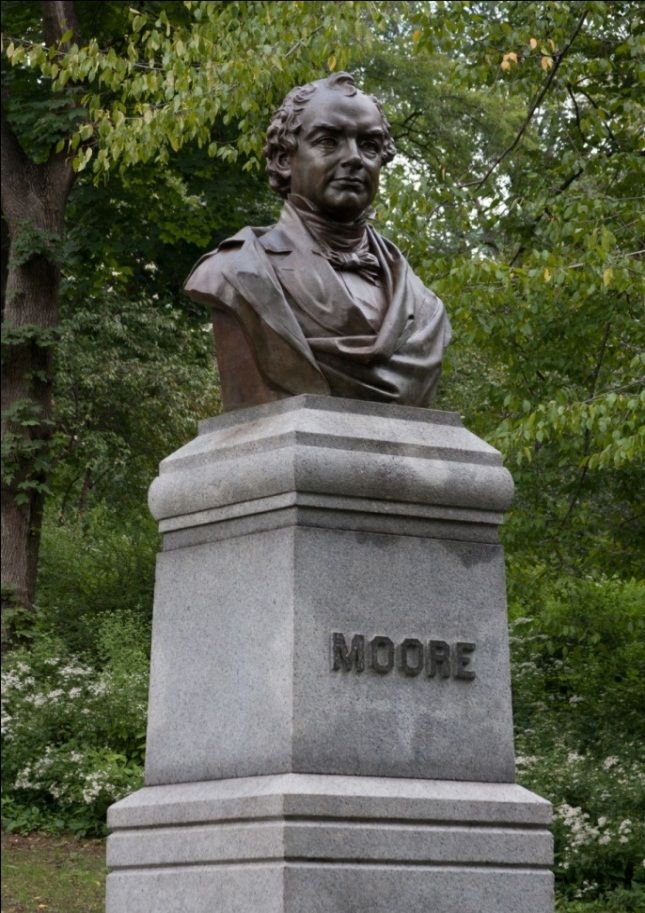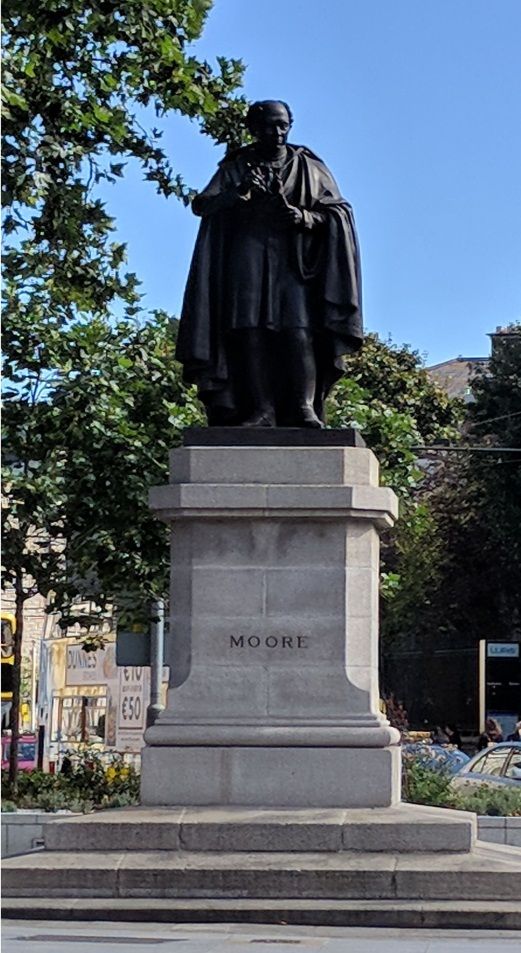An raibh a fhios agat? Did you know?
Thomas Moore
To achieve fame and status as a poet is no mean achievement. That goal was achieved by one Thomas Moore of Dublin. He was acclaimed as national lyric poet of Ireland in 1812, according to Moran (2013). His work had found a willing audience as he switched from the call to the bar to the nuanced methodology of the scribe. This brief overview looks at his life, his suggested detachment from his earlier revolutionary views and his creative qualities as a poet.
Introduction
Moore was born in a house in Aungier Street Dublin, directly over the family grocery business on the 28th May 1779. He was brought up a Catholic and from an early age displayed a keen interest in music. On his journey to achieve greatness he was one of the first Catholics to attend Trinity College in 1795. This brought him into contact with people such as Robert Emmet. They were both members of the college’s historical society. His mother had envisaged a career in the legal profession for her son but he had apparently become intoxicated to an extent by the tremors of Revolution that pervaded Dublin at the time as a result of the French Revolution of 1789. Indeed Moore wrote an appeal in 1797 to his fellow students in the United Irishman to resist any attempt by Britain to coerce Ireland into a union with it.
As a consequence Moore was to face the charge of sedition at Trinity in 1798. Moore according to Kelly (2003) was interrogated by the authorities but haven’t been on the fringes of events wasn’t seen as a key figure and escaped any penalty. Emmet however, was expelled in absentia. Emmet had been of the view that the article would bring unwanted attention to their activities and so it proved. Interestingly, Kelly (2003) posits that Moore showed a distant interest in the political situation unfolding at that time. Despite his claim to having republican leanings, his family having rubbed shoulders with people like Napper Tandy, Moore seems to have decided to confine his earlier rebellious utterances to the political sidelines and instead would make his way to London to put his pen to use in writing verse. However, it would prove that Moore didn’t agree with the loss of life in achieving political aims. Kelly (2003) also credits Moore with having penned a piece in the United States, after his brief sojourn in Bermuda, which appears to have supported the aspirations of people like Emmet.
In terms of recognition Moore is regarded as one of the leading poets of his generation. Writing in the Irish Times Fintan O’Toole (2005) uses the term ’Superstar’. He puts this in context by recounting that Moore was paid £500 annually for over twenty five years for his 10 volume work, Irish Melodies (1807-1834), not exactly a pittance back in the 19th Century. His work was also translated in most European languages O’Toole (2005) continues, including Russian and Polish. He also achieved success in the U.S. where his piece The Last Rose of Summer sold over a million copies. Moore was the first Irish writer to achieve both national and international recognition for his work, particularly his 10 volume Irish Melodies, according to Nolan (2006). His work was admired in the upper echelons of English parlour society Nolan (2006) opines and equally within the ranks of a resurgent Irish nationalist movement. The Irish music revivalist movement if you would, owes a depth to one Edward Bunting from Belfast. Bunting it was who appreciated the symbolism attached to the harp. The harp with its huge symbolic connotations had practically died a death having been seen by some as an instrument of insurrection. Bunting however traversed the country, collecting tunes and melodies which acted as a catalyst of rejuvenation. This was promoted at the Belfast Harp Festival of 1792.

Moore’s subsequent treatment of these airs did not meet with the approval of Bunting it appears, according to Nolan (2006). Indeed it was a collaborationist, Sir John Stephenson, who put his interpretation on Bunting’s airs that would give vitality to Moore’s words. The festival it should be noted was part of a United Irishman event to mark the 3rd anniversary of the fall of the Bastille. While Moore is perhaps sometimes attacked for his non-committal attitude towards insurrection, others point predominantly to his poetry and song with its thinly disguised sentiments. A classic example of this would be his world-renowned ‘The Minstrel Boy’. The song has clear connotations about ‘freedom and the fight for Liberty. Indeed some suggest that it was a tribute to Robert Emmet and Wolfe Tone.
There is however another interesting take on this by Ryan (1998) who proffers that the song might eerily reflect on the life of his son, Thomas, who alas had died rather mysteriously at the tender age of twenty eight while in Africa. Thomas junior was a professional soldier serving with the French Foreign Legion hence the comparison with the lyrics that he had indeed entered the” ranks of death”…a line that resonates from the Minstrel Boy. The Last rose of summer, another poem from Moore, might again be reflective of his son Thomas, the last of his five children who was taken from them, being predeceased by his four siblings.
The Minstrel Boy
The minstrel boy to the war is gone
In the ranks of death you will find him
His father's sword he's girded on
And his wild harp slung behind him
"Land of Song" said the warrior bard
"Tho' all the world betrays thee
One sword, at least, thy rights shall guard
One faithful harp shall praise thee"
The minstrel fell but the foeman's chains
Could not bring that proud soul under
The harp he loved never spoke again
For he tore its chords asunder
And said, "No chains shall sully thee
Thou soul of love and brav'ry
Thy songs were made for the pure and free
They shall never sound in slavery"Thomas Moore
Conclusion
We associate Moore’s famous melody ’The Minstrel Boy’ with occasions such as on St. Patrick’s Day celebrations. The same event is held in high esteem amongst the Irish of North America where everything Irish is laid bare amidst the strains of the bagpipes playing Moore’s piece. His memory lives on both in musical terms and in verse. He also wrote the satirical Memoirs of Captain Rock. It should be remembered that the 'Rockites' were an agrarian rebel movement that visited reprisals and worse afflictions upon the ruling English and Anglo-Irish landlords in the 1820s. Returning to Kelly( 2003) he reminds us that in his biography on Edward Firzgerald, Moore lay in his sick bed but later placed his sentiments and admiration with the stricken hero. Some people might be of the view that Moore's name has been lost somewhere in our appreciation of great Irish scribes. Others however might retort that his genius lies on the wings of the melodies of memory. He died on the 25th Feb. 1852 and is buried in St.Nicholas churchyard near Bromham Wiltshire, England. His epitaph speaks volumes.
Dear Harp of my Country! In darkness I found thee,
The cold chain of silence had hung o'er thee long;
When proudly ,my own Island Harp, I unbound thee,
And gave all thy cords to light, freedom and song. Thomas Moore
Antóin Ó Lochraigh, Bard & Soloist
Bibliography
Kelly.R. (2003) Another Side of Thomas Moore. History Ireland, Vol. 11, No. 3, Robert Emmet Bicentenary (autumn, 2003), pp. 39-43 JOURNAL ARTICLE.
MORAN.S. (2013) GREAT IRISH PEOPLE, LIBERTIES PRESS, TERENURE, DUBLIN. IRELAND
NOLAN E. (2006) Irish Melodies and Discordant Politics: Thomas Moore's "Memoirs of Captain Rock" (1824) JOURNAL Vol. 2 (2006), pp. 40-53: Field Day Publications
O’TOOLE. F (2005) FASHIONING THE AIRS THAT WE BREATH. THE IRISH TIMES, DUBLIN, IRELAND.
ROCK.A. PHOTOS COURTESY OF
RYAN. G.E. (1998) Thomas Landsdowne Parr Moore, Son and Legionnaire. New Hibernia Review / Iris Éireannach Nua. Vol. 2, No. 3 (autumn, 1998), pp. 117-126 University of St. Thomas (Centre for Irish Studies) JOURNAL ARTICLE

What You Can Expect
A walk through Dublin City in the company of a native Dubliner with the emphasis on history, culture and the great Irish ability to tell a story and to sing a song. In addition, and at no extra cost an actual rendition of a self-penned verse or perhaps a spot of warbling. I'd like to share my love of history with you, after all the past is our present and should be part of our future.
About The Tours
Tours are in English, with Irish translations, where appropriate. I also speak Intermediate level Dutch. Duration: 3 hours approx., with a short break in-between. Tour prices and booking options are available in the booking section.
The contact hours are Monday to Sunday, 09:00 - 20:00 IST.
Special Options
We can also arrange a half-day private tour for a maximum of twelve people. This incorporates a collection of parts of our three Tours combined. Tour duration 4-5 hours approx. A break for refreshments in between. Group of 2: €50 per person, Group of 3: €30 p.p., Group of 4 or more: €25 p.p. Refreshments: €10 approx. (This is an extra). Please contact us for details.
Copyright ©2025 Tailteann Tours
Designed by Aeronstudio™



